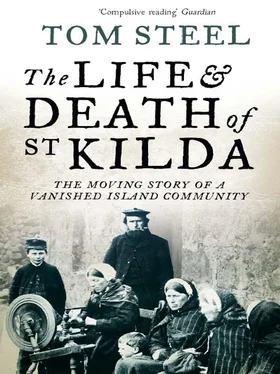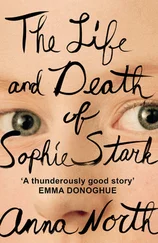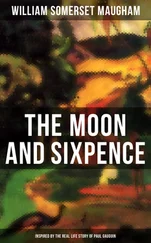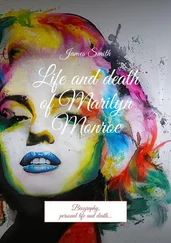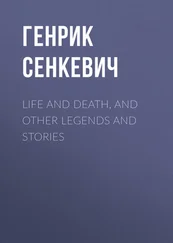The most dangerous operation of all, however, was the ascent of the cliffs from the sea. An island boat would be taken round to the foot of Conachair and two cragsmen would climb by turns in true alpine fashion. In such cases an end of the rope was attached to both fowlers so that in the event of the foremost losing his footing, his companion would be able to break his fall.
The fulmar is capable of spitting the vile-smelling oil contained in its stomach some two or three feet. To the St Kildans, the oil was valuable. ‘As you were going down the rock on the rope,’ remembers Lachlan Macdonald, ‘you try and hide yourself as much as you can. The young fulmars were just about the stage to fly, right enough, but if you don’t get them quickly they’ll make an awful mess of you. They’d spew that oil out on you.’ The fowlers had also to be wary of being startled by such an action lest they be thrown off balance and fall off the face of the cliff. In order to retain the oil in the bird’s stomach, the St Kildans gave the neck a twist.
Sometimes the fulmars nested in places out of reach of a fowler on the end of a rope. To capture them, the St Kildans used a fowling rod, which they made themselves. This was a bamboo pole about fifteen feet long, to one end of which was attached a thin strip of cane. A running noose, made of plaited horsehair or wire and stiffened with a gannet’s quill to maintain a bow, was attached to the cane. With a fowling rod the St Kildans could easily lasso the unsuspecting, inaccessible bird.
The killing lasted a fortnight. Every evening the fulmars were laid in a heap by the shore in front of the village and divided out carefully and equally amongst the islanders. Although the cliffs themselves were divided out before the harvest began, the St Kildans also shared the final catch. ‘You see, supposing you had a share in the cliffs,’ says Lachlan Macdonald, ‘you might have a lot more than the other fellow, so it was fairer to share them all when they came home so that there wouldn’t be any difference.’
‘They all put them in one place,’ recalls Neil Ferguson, ‘and they shared them out – so much for each house – and when they took them home they started plucking them and cleaning them. The old men salted them and the young boys cut their feet and head off and the women took the guts out, and that was the way of it. Next morning you went for another load. That went on until you had two big barrels of fulmars salted. They didn’t get much sleep at all. They would be working till maybe two or three in the morning and away again at eight o’clock for some more.’ Every islander was given an equal share of the harvest, whether or not he or she had taken part in the work. The only exceptions to the rule of absolute equality were those fulmars killed while out of the nest, which the fowler was allowed to keep for himself. The reason why was explained to John Ross by an islander. ‘Should they be left out there all night,’ he said, ‘the ravens, hawks or crows would have eaten them up and they would do good to no one.’
The St Kildans had a use for every part of the fulmar. The feathers, a valuable source of income, were graded according to colour and put into sacks. The fulmar oil, of which every bird normally yielded anything up to half a pint, was poured out of the gannet stomachs into canisters to be bartered when the factor came. Those birds that were to be preserved for eating in winter were split lengthways down the back and filled with salt. They were then packed like herring in barrels. The entrails of the birds were often used as fishing bait, while the bones were condemned to the midden at the back of the house to become a good, rich fertilizer by the following spring. A large number of birds, of course, would be eaten fresh. The carcasses were boiled and the fat that came out of them, once cooled, could be skimmed off and used in the islanders’ lamps. ‘All this time there is nothing but birds, fat and feathers everywhere,’ remarked the Reverend Neil Mackenzie of the village at the time of the harvest. ‘Their clothes are literally soaked in oil, and everywhere inside and outside their houses, nothing but feathers; often it looks as if it were snowing.’
Traditionally, the St Kildans did not use salt to preserve the flesh of the sea birds. Salt was frequently scarce and to a poor people often expensive. The strong winds that are rarely absent from Hirta were used instead to stop the carcasses from going bad during the winter months. To be preserved by the wind, however, the birds had to be kept dry and the islanders built hundreds of little stone storehouses called cleits that allowed the wind to pass over the food, but not take with it any moisture.
Cleits are unique to St Kilda. Without them life would not have been possible on such a damp and wet island. They were constructed entirely out of stone and turf. The granophyre slabs that litter the eastern part of the island were admirably suited to the building of corbelled, dry-stone walls. Large, flat slabs covered with turf provided the structure with a roof. For strength as well as dryness, the little doorway was normally set in the end of the cleit facing the hillside. The cleits were usually about eight to twelve feet in diameter and four or five feet high. Those built by the St Kildans inside the wall surrounding the village were used mainly to store the carcasses of sea birds and were round in shape.
The greatest concentration of cleits lies in the Village Bay area, but the islanders built hundreds more on Hirta, some on the slopes of Conachair, others on Oiseval. Beyond the wall, cleits were used to store practically everything that had to be kept dry, like ropes, feathers and even clothing. High on the hill-slopes they were used almost exclusively to dry and store the lumps of turf for the fires of Village Bay.
At the end of the fulmar harvest, the St Kildans would take two or three days’ rest. Exhausted by their labours, they could relax for a while in the knowledge that safely stored away were some of the food supplies that would keep them alive in winter. But another harvest still remained to be reaped, that of the young gannet, or guga.
St Kilda, then as now, could claim to be the largest gannetry in the world. A count of the colony taken in 1960 revealed that some 40,000 pairs breed on Boreray, Stac Lee, and Stac an Armin. Until the nineteenth century the gannet was the buttress of the community’s economy: the oils and feathers of the bird helped pay the rent and provide the people with essential supplies from the mainland.
The gannet builds its nest on ledges of rock. The female lays one egg which is incubated by both sexes for anything up to forty-five days. When the chick hatches it is black and naked but soon develops a white down. By September, the down is replaced by brown feathers. It was then that the St Kildans would prepare for the most spectacular and dangerous task of their year, the hunting of the gannet.
The gugas had to be killed at night, when the birds would be on their nests. Usually a dozen men were involved in the trip – seven would land on Boreray and the other five would stay in the boat and row and drift round the island all night. ‘This island’, wrote George Atkinson, ‘is more universally precipitous than St Kilda, and to a timid or awkward person would be really difficult to land on.’ Before a landing was attempted each man would remove his boots and don a pair of heavy woollen socks.
‘The St Kildans’, continued Atkinson, who went with a party of islanders to Boreray in the summer of 1831, ‘are very dexterous in landing or embarking on, or from, a rocky shore, where the long, heavy swell of the Atlantic keeps the boat rising and falling by the side of the cliff, a height of fourteen or fifteen feet, even when the sea appears quite calm. The boat is placed with her broadside to the rock and kept from striking by a man in the head and stern, each with a long pole for the purpose. One of their barefooted climbers stands ready in the middle with a coil of rope on his arms, and seizing an opportunity springs on the rock and establishes himself firmly on some rough projection. He then hauls on the rope, the other end of which, I should have observed, is held by some in the boat, or attached to it, and giving way when the boat falls, tightens the rope at its rising. Another companion joins him and standing three or four feet from him employs another rope in a similar manner, so that together they form a firm and safe gangway or railing, for an inexpert person to spring to land by.
Читать дальше
